Rhinoceros
 From Nwe
From Nwe | Rhinoceros |
||||||||||
|---|---|---|---|---|---|---|---|---|---|---|
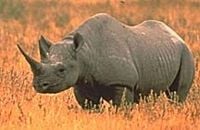
Black Rhinoceros, Diceros bicornis
|
||||||||||
| Scientific classification | ||||||||||
|
||||||||||
|
|
||||||||||
Ceratotherium |
The rhinoceros (plural rhinoceros, rhinoceroses, or rhinoceri) or rhino is any of the odd-toed ungulates (order Perissodactyla) comprising the biological family Rhinocerotidae. There are five surviving species, two of which are native to Africa and three to southern Asia. These mammals are all large, thick-skinned herbivores and have either one or two horns (actually thickly matted hair) on the upper snout.
Despite adding to the human fascination with nature, in the twentieth century the rhinoceros has been hunted to the brink of extinction, often sought by hunters only for their horn. Four of the five species are either endangered or critically endangered. Only the white rhinoceros, which is listed as near-threatened, is no longer endangered. There are only about 60 individuals left of the Javan rhinoceros.
Description
In the odd-toed ungulates, comprising the order Perissodactyla, the central axis of the foot passes through the third toe. In rhinoceroses, the first and fifth toes are lost and the animal walks on the remaining three toes. In horses, only the third toe remains and supports the whole weight of the animal. Tapirs have four toes on their front feet and three on their hind feet.
The odd-toed ungulates arose in what is now North America during the late Paleocene, less than 10 million years after the dinosaurs died out. By the start of the Eocene (55 million years ago), they had diversified and spread out to occupy several continents. The horses and tapirs both evolved in North America; the rhinoceroses appear to have developed in Asia from tapir-like animals and then spread to the Americas during the middle Eocene (about 45 million years ago).
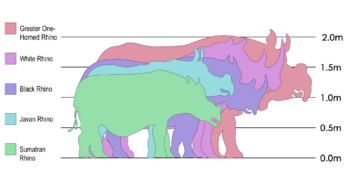
The family Rhinocerotidae is characterized by large size (one of the few remaining megafauna, animals whose average adult weight exceed 100 pounds or 44 kg, surviving today) with all of the species capable of reaching one ton or more in weight. The largest known perissodactyl in the fossil record, an Asian rhinoceros called Paraceratherium, reached 11,000 kg (12 tons), more than twice the weight of an elephant.
The surviving species of rhinoceros have a thick protective skin, 1.5-5 centimeters thick, formed from layers of collagen positioned in a lattice structure. Rhinos have an elongate skull, which is elevated posteriorly and a relatively small braincase for mammals this size (400-600g).
Rhinoceros have one or two projections on the upper snout. These "horns" are not really true horns, but are epidermal derivatives, composed of a solid mass of thickly matted hair—keratin, a hair protein—that grows from the skull without skeletal support.
The nasal bones project forward freely and may extend beyond and above the premaxillae. The surface of the nasals where the horns sit is roughened. There is a strongly developed occipital crest. Rhinos have 24-34 teeth, mostly premolars and molars for grinding (dental formula 1-2/0-1, 0/1-1, 3-4/3-4, 3/3). The canines and incisors are vestigial except for the lower incisors in Asian rhinos, which are developed into powerful slashing tusks.
Rhinoceros are herbivorous. They have acute hearing and an excellent sense of smell, but poor eyesight over any distance. Most rhinoceros live to be about 50 years old or more. The collective noun for a group of rhinoceros is "crash."
The African and the Asian rhinoceros have some distinct characteristics. Morphologically, one obvious difference is that both African varieties have two horns in tandem while the Sumatran rhino has two horns, but one typically is a stub, and the other two Asian types have a single horn. Behaviorally, it has been found that African rhinos are more aggressive than Asian rhinos. African rhinos fight with their horns, using them to impale and throw their adversaries, while the Asian rhino fights with their bottom teeth, using them in a slashing motion. Their feeding habits vary as well. African rhinos feed low to the ground, whereas the Asian rhino browses on leaves that are higher up.
However, the two groups have a lot of behavioral similarities. Both African and Asian rhinos are more active in the evening, night, and early morning, while spending the hot day time resting in the shade. Both groups are herbivores and feed primarily on grass or branches; depending on the species, some may eat more grass than branches. Both African and Asian rhinos sleep in both standing and laying positions and both enjoy wallowing in muddy pools and sandy riverbeds.
The word "rhinoceros" is derived from the Greek words rhino, meaning nose, and keras, meaning horn; hence "horn-nosed."
White rhinoceros
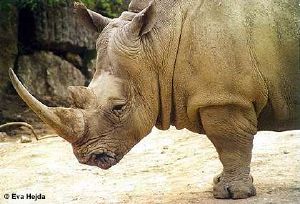
The white rhinoceros, or square-lipped rhinoceros (Ceratotherium simum), is one of the five species of rhinoceros that still exist. After the elephant, it is probably the most massive remaining land animal in the world, along with the Indian rhinoceros, which is of comparable size. It is well known for its wide mouth used for grazing and for being the most social of all rhino species. The white rhino is the most common of all rhinos and consists of two subspecies, with the northern subspecies being rarer than the southern. The northern subspecies may have as few as 50 specimens remaining worldwide.
The name white rhino originated in South Africa where the Afrikaans language developed from the Dutch language. The Afrikaans word "wyd" (derived from the Dutch word "wijd"), which means "wide," referred to the width of the rhinoceros' mouth. Early English settlers in South Africa misinterpreted the "wyd" for "white." So the rhino with the wide mouth ended up being called the white rhino and the one with the narrow pointed mouth was called the black rhinoceros. The wide mouth was adapted to cropping large swaths of grass, while the narrow mouth was adapted to eating leaves on bushes.
A white rhino's skin color is quite similar to that of the black rhino. An alternative common name for the white rhinoceros, more accurate but rarely used, is the square-lipped rhinoceros. The white rhinoceros' genus, Ceratotherium, appropriately means "horned beast."
Unlike the other species of rhinoceros, the white rhino is a more social animal, forming groups rather than being solitary. A typical group consists of mother and offspring. However, larger groups, including several subadults as well as one or more adult females, also are formed. Subadults almost always form groups with one or more subadults of similar age, of the same or opposite sex, or with an adult female lacking a calf. Adult males are solitary, except when accompanying females.
The gestation period of the rhino is 16 months and the calf is born weighing about 65 kilograms (145 pounds). Usually the cow comes into heat while suckling a calf and once the new calf is born the older one, having been weaned, is driven away.
By 2000, more than 10,000 white rhinos existed in the wild. However, due to the value of their horns and how easy it is to hunt them, this number is dwindling and the white rhino's population is decreasing. It is listed as Near Threatened by IUCN.
Black rhinoceros
The black rhinoceros, Diceros bicornis, also colloquially black rhino, is native to the eastern and central areas of Africa, including Kenya, Tanzania, Cameroon, South Africa, Namibia, and Zimbabwe.
Although the rhino is referred to as "black," it is actually more of a gray-white color in appearance. The name of the species was chosen to distinguish it from the white rhinoceros (Ceratotherium simum). This is very misleading, as those two species are not really distinguishable by color. As noted above, the word "white" in the name "white rhinoceros" is derived from the Afrikaans word for "wide" rather than for the color white.
Unlike the white rhino, the black rhino is a solitary animal rarely forming groups. A female and her offspring are the usual group, whereas, males are mostly solitary except when courting a female. When male adult black rhinos meet they often perform a complex ceremony involving stiff-legged scraping, imposing postures, and short charges sometimes accompanied by screaming groans. The male rhinos, or bulls, also mark their territory. They do so by dragging their legs, spraying surrounding bushes with urine, and creating dung heaps.
Similar to the white rhinoceros, black rhinoceros cows go into heat during the African wet season and therefore give birth to their calves in late summer. Gestation lasts for 15 months and the calf is born weighing 20-25 kilograms (9-11 pounds). Calves leave their mother when her next offspring are born and often form groups with other calves their age.
The World Conservation Union (IUCN) announced on July 7, 2006, that one of the four subspecies, the West African Black Rhinoceros (Diceros bicornis longipes), has been tentatively declared as extinct.
Sumatran rhinoceros
The Sumatran rhinoceros, Dicerorhinus sumatrensis, is the smallest extant rhinoceros species, as well as the one with the most fur. Due to habitat loss and poaching, its numbers have declined and it is one of the world's rarest mammals. The Sumatran rhinoceros is the last surviving species in the same group as the extinct woolly rhinoceros.
The Sumatran rhinoceros' thick fur not only helps it survive in the high altitudes of Sumatra and Borneo but it allows a very thick coat of mud to stick to the rhino and prevent insect bites and thorns.
Formerly, the Sumatran rhinoceros extended in a continuous distribution as far north as Myanmar and eastern India but poaching has made it extinct in Thailand and Vietnam. It has not been seen in Cambodia, Laos, or Myanmar for many years. Now, they are mainly found only in Sumatra and Borneo.
The mating of the Sumatran rhino is very aggressive. Gestation lasts 475 days, with the calf's weight at birth being about 33 kilograms (14 pounds). At 16-17 months of age, the calf is ready to leave his mother. She will move back to the non-breeding range and the calf will stay close to the salt lick (a naturally occurring salt deposit that animals lick to obtain minerals they need).
Poaching and encroachment remain a large threat to the Sumatran rhinos and they are currently listed as Critically Endangered by the IUCN.
One-horned rhinoceroses
The members of the genus Rhinoceros are the one-horned rhinoceroses. The genus contains two species: The Indian rhinoceros (Rhinoceros unicornis) and the Javan rhinoceros (Rhinoceros sondaicus). The Javan rhinoceros is one of the most endangered large mammals in the world with only 60 individuals surviving, in only two known locations: Java (Indonesia) and Vietnam.
The one-horned rhinoceros is a solitary animal; however they tend to congregate in bathing pools and feeding areas. The one-horned rhino males are aggressive and are known to challenge other males for dominance. Submissive males may share the home range of a dominant male, but unlike the dominant male they do not squirt-urinate, and they run away if challenged. Indian rhinos, or one-horned rhinos, are highly vocal animals and produce a variety of sounds.
The female one-horned rhino ensures she chooses the strongest bull as a mate by making a series of rhythmical whistling sounds and running extremely fast. The bull that can catch her will usually be the strongest bull in the area.
Gestation lasts around 16 months and the birth weight of the calf is 65-70 kilograms (140-150 pounds). The calf continues to live and nurse with the mother until 2 years of age and will be driven off 1-2 weeks before the birth of the next calf.
The Indian rhinoceros is listed as Endangered by the IUCN. The surviving population totals at about 2,400. But it seems to be improving as the rhinos have been moved to establish new populations at new parks in Nepal and India.
Rhinoceros horns
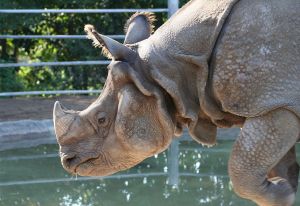
The most obvious distinguishing characteristic of the rhinos is a large horn above the nose. Rhinoceros horns, unlike those of other horned mammals, consist only of keratin, fibrous structural proteins, and lacks a bony core, such as bovine horns. However it has been discovered by scientists at Ohio University that the rhinoceros horn actually contains calcium and melanin deposits. They believe that the calcium is what gives the core its hardness and the melanin protects it from the sun. Rhinoceros horns are used in traditional Asian medicine and for dagger handles in Yemen and Oman.
One repeated fallacy is that rhinoceros horn in powdered form is used as an aphrodisiac in Traditional Chinese Medicine (TCM). It is, in fact, prescribed for life-threatening fevers and convulsions and has been clinically shown to have fever-reducing properties (Bensky et al. 2004). An extensive review of rhinoceros horn in TCM Materia Medica shows no aphrodisiac use and the source of the fallacy is not clear unless it was a supposition based on the form when sources were more difficult to find in English (Parry-Jones and Vincent 1998). China has signed the CITES treaty. However, to prevent poaching, in certain areas rhinoceroses have been tranquilized and their horns removed.
Legend
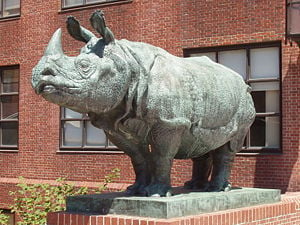
There are a number of legends about rhinoceroses stamping out fire. The story seems to have been common in Malaysia, India, and Burma. This type of rhinoceros even had a special name in Malay, badak api, where badak means rhinoceros and api means fire. The animal would come when a fire is lit in the forest and stamp it out. Whether or not there is any truth to this has not yet been proven, as there has been no documented sighting of this phenomenon in recent history. It may be false or the lack of evidence may stem from the fact that rhinoceros sightings overall in Southeast Asia have become very rare, largely due to widespread poaching of the critically endangered animal.
Classification
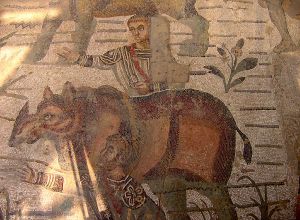
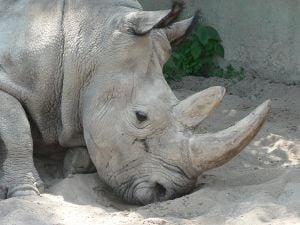
Several rhinoceros species became extinct within geologically recent times, notably the Giant Unicorn and the Woolly Rhinoceros in Eurasia. The extent to which climate change or human predation was responsible is debated. Current evidence indicates that they probably had survived many climate changes before modern humans arrived.
Rhinoceros-like animals first appeared in the Eocene as rather slender animals, and by the late Miocene there were many species. Most were large. Rhinos in North America became locally extinct during the Pliocene, and in northern Asia and Europe during the Pleistocene.
The five living species fall into three categories. The critically endangered Sumatran rhinoceros is the only surviving representative of the most primitive group, the Dicerorhinini, which emerged in the Miocene (about 20 million years ago) (Rabinowitz 1995). The extinct woolly rhinoceros of northern Europe and Asia was also a member of this tribe. There are two living Rhinocerotini species, the endangered Indian rhinoceros and the critically endangered Javan rhinoceros, which diverged from one another about 10 million years ago. The two African species, the white rhinoceros and the black rhinoceros, diverged during the early Pliocene (about 5 million years ago) but the Dicerotini group to which they belong originated in the middle Miocene, about 14 million years ago.
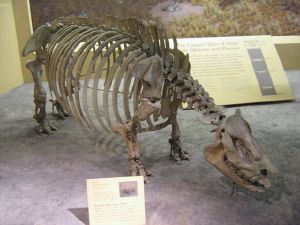
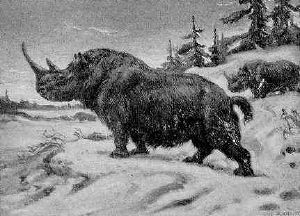
- Family Rhinocerotidae
- Subfamily Rhinocerotinae
- Tribe Aceratheriini
- Aceratherium (extinct)
- Acerorhinus (extinct)
- Alicornops (extinct)
- Aphelops (extinct)
- Chilotheridium (extinct)
- Chilotherium (extinct)
- Dromoceratherium (extinct)
- Floridaceras (extinct)
- Hoploaceratherium (extinct)
- Mesaceratherium (extinct)
- Peraceras (extinct)
- Plesiaceratherium (extinct)
- Proaceratherium (extinct)
- Sinorhinus (extinct)
- Subchilotherium (extinct)
- Tribe Teleoceratini
- Aprotodon (extinct)
- Brachydiceratherium (extinct)
- Brachypodella (extinct)
- Brachypotherium (extinct)
- Diaceratherium (extinct)
- Prosantorhinus (extinct)
- Shennongtherium (extinct)
- Teleoceras (extinct)
- Tribe Rhinocerotini
- Gaindatherium (extinct)
- Rhinoceros—Indian & Javan Rhinoceros
- Tribe Dicerorhinini
- Coelodonta—Woolly Rhinoceros (extinct)
- Dicerorhinus—Sumatran Rhinoceros
- Dihoplus (extinct)
- Lartetotherium (extinct)
- Stephanorhinus (extinct)
- Tribe Ceratotheriini
- Ceratotherium—White Rhinoceros
- Tribe Dicerotini
- Diceros - Black Rhinoceros
- Paradiceros (extinct)
- Tribe Aceratheriini
- Subfamily Elasmotheriinae
- Gulfoceras (extinct)
- Tribe Diceratheriini
- Diceratherium (extinct)
- Subhyracodon (extinct)
- Tribe Elasmotheriini
- Bugtirhinus (extinct)
- Caementodon (extinct)
- Elasmotherium—Giant Unicorn (extinct)
- Hispanotherium (extinct)
- Huaqingtherium (extinct)
- Iranotherium (extinct)
- Kenyatherium (extinct)
- Menoceras (extinct)
- Ougandatherium (extinct)
- Parelasmotherium (extinct)
- Procoelodonta (extinct)
- Sinotherium (extinct)
- Subfamily Rhinocerotinae
References
ISBN links support NWE through referral fees
- Ballenger, L., and P. Myers. 2001. Rhinocerotidae. Animal Diversity Web. Retrieved July 11, 2007.
- Bensky, D., S. Clavey, E. Stoger, and A. Gamble. 2004. Chinese Herbal Medicine: Materia Medica, third edition. Seattle: Eastland Press. ISBN 0939616424
- Forster, L. 1998. Scientists crack rhino horn. Research News. Ohio University. Retrieved July 26, 2008.
- Grzimek, B., D. G. Kleiman, V. Geist, and M. C. McDade. 2004. Grzimek's Animal Life Encyclopedia. Detroit: Thomson-Gale. ISBN 0787657883
- Hieronymus, T. L., and L. M. Witmer. 2004. Rhinoceros horn attachment. Ohio University. Retrieved July 28, 2007.
- Laufer, B. 1914. History of the rhinoceros. In Chinese Clay Figures, Part I: Prolegomena on the History of Defence Armor. Field Museum of Natural History, Chicago.
- Parry-Jones, R., and A. Vincent. 1998. Can we tame wild medicine? To save a rare species, Western conservationists may have to make their peace with traditional Chinese medicine. New Scientist 157(2115): 3.
- Robinson, T. J., V. Trifonov, I. Espie, and E. H. Harley. 2005. Interspecific hybridization in rhinoceroses: Confirmation of a Black × White rhinoceros hybrid by karyotype, fluorescence in situ hybridization (FISH) and microsatellite analysis. Conservation Genetics 6(1): 141-145. Retrieved July 28, 2007.
Credits
New World Encyclopedia writers and editors rewrote and completed the Wikipedia article in accordance with New World Encyclopedia standards. This article abides by terms of the Creative Commons CC-by-sa 3.0 License (CC-by-sa), which may be used and disseminated with proper attribution. Credit is due under the terms of this license that can reference both the New World Encyclopedia contributors and the selfless volunteer contributors of the Wikimedia Foundation. To cite this article click here for a list of acceptable citing formats.The history of earlier contributions by wikipedians is accessible to researchers here:
- Rhinoceros history
- White_Rhinoceros history
- Black_Rhinoceros history
- Sumatran_Rhinoceros history
- Rhinoceros_(genus)133282341 history
The history of this article since it was imported to New World Encyclopedia:
- History of "Rhinoceros"
Note: Some restrictions may apply to use of individual images which are separately licensed.
↧ Download as ZWI file | Last modified: 02/04/2023 12:38:20 | 51 views
☰ Source: https://www.newworldencyclopedia.org/entry/Rhinocerotidae | License: CC BY-SA 3.0
 ZWI signed:
ZWI signed: KSF
KSF